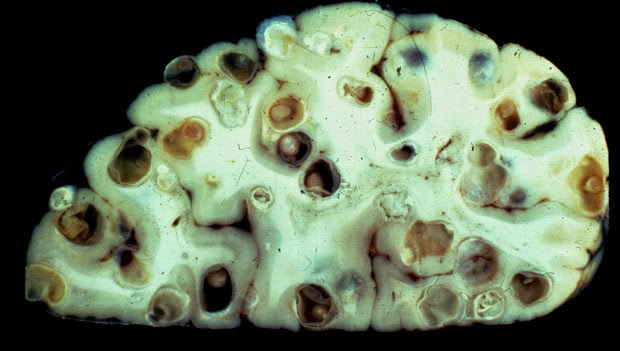| Image from Daily Mail. |
 |
| T. saginatum scolex imaged using electron microscopy. Image taken from the internet. |
In order to get your own tapeworm infection, all you have to do is consume poorly cooked beef which contains T. saginatum eggs. When the eggs "hatch", oncospheres (infective larva) migrate to the small intestine, where they will take 3 months to mature into an adult worm. Adult worms are typically 2 to 10 meters in length. Usually only one worm is found, unless you've consumed a heavily contaminated piece of meat or ate fecal matter that's full of gravid proglottids (the end pieces of the tapeworm). Fun fact: eggs can survive for months once they've left the body. Beware of old poop!
 |
| Taeniasis life cycle for T. saginatum and T. solium, via the CDC |
Patients infected with a beef tapeworm (clinically described as "Taeniasis") may complain of non-specific abdominal symptoms, such as nausea, general pain and discomfort, or weight fluctuations. I say weight fluctuations because most people experience extreme weight loss (often misdiagnosed as anorexia), especially those affected in developing countries (where these parasites are most prevalent), but there have been a number of people who have infected themselves, by choice, and have reported it being "no big deal" or that they gained weight (see my favorite example: Michael Mosley of the BBC News). So, while most people experience weight loss, I suppose you could say that depends on your socioeconomic status, and whether or not you've had a choice to become infected.
 |
| T. solium life cycle from the Food and Agriculture Organization of the United Nations (fao.org) |
 |
| T. solium scolex. Image from UNAM. |
 |
| T. solium adhering to the epithelial cells of the intestine. Image from UNAM. |
 |
| T. solium cysts in a human brain. Image from Discover Magazine. |
The National Institute of Allergy and Infectious Disease (NIAID) just released an article about the treatment-induced inflammatory response in pigs with neurocysticercosis. The current treatment of Praziquantel is apparently causing inflammation, blood vessel leakage, and damage to the blood-brain barrier. This means that new drugs need to be developed that can reduce inflammation at the site of the cyst(s) while maintaining the integrity and functionality of the blood-brain barrier and blood vessels.
 |
| Photo of the surface of the brain of a pig
treated with the antiparasitic drug praziquantel showing blue-dyed (blue
arrows) and clear (white arrows) cysts. The blue dye indicates
disruptions in the blood-brain barrier. Image from NIAID/ Dr. Cristina Guerra-Giraldez. |
Want to avoid tapeworms and neurocysticercosis? The best way to do that is either to avoid eating meat, or to make sure your meat is cooked properly. Cooking meat properly is the best way to inactivate or kill most infectious diseases associated with meat consumption.
One of the major reasons diseases are so rampant in livestock is because a lot of treatments (mainly antibiotics) are used as prophylactics instead of at the onset of infection and symptom presentation. Animals that are raised in small, confined areas are more likely to be exposed to illnesses. When you are raising animals on a large scale and rely on them for income (whether through livestock trade, meat or dairy production), it can be really scary when one of your animals gets an infection, because you risk losing some of your income. It's obviously unethical to sell/trade sick animals, but it happens all the time, and is one of the main causes for the spread of disease to other regions. When prophylactic treatments are used, resistant infections are more likely to occur, which is an even larger problem (as I'm sure you can imagine).
Even if the meat you consume came from a healthy cow/pig/lamb/goat/chicken/turkey/etc., it might have been slaughtered in the same environment as a sick animal, which still puts you at risk. So, if you have a tendency to order your meat "rare", be sure you know the risks associated with that choice.
Edited to add:
I want to be clear that, even though I'm vegan, I believe choosing to be vegan is a very personal choice and no one should ever be bullied in to it. But, I also feel the need to add some information about the environmental impacts of eating meat to this post, since we are talking about risks associated with consuming meat. Considering the risks to yourself is very important, so you can actively minimize your risk of getting an infection or other serious health disparity (mostly through the long-term, excessive meat consumption), but considering the long-term risks for the environment (ie- everyone on earth) is also really important. Here are some articles that you might want to consider reading before making a definitive decision about your dietary habits:
2500 gallons all wet?: EarthSave

